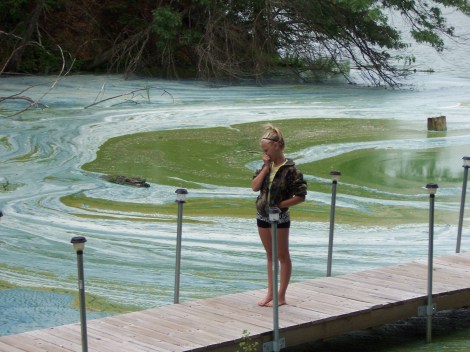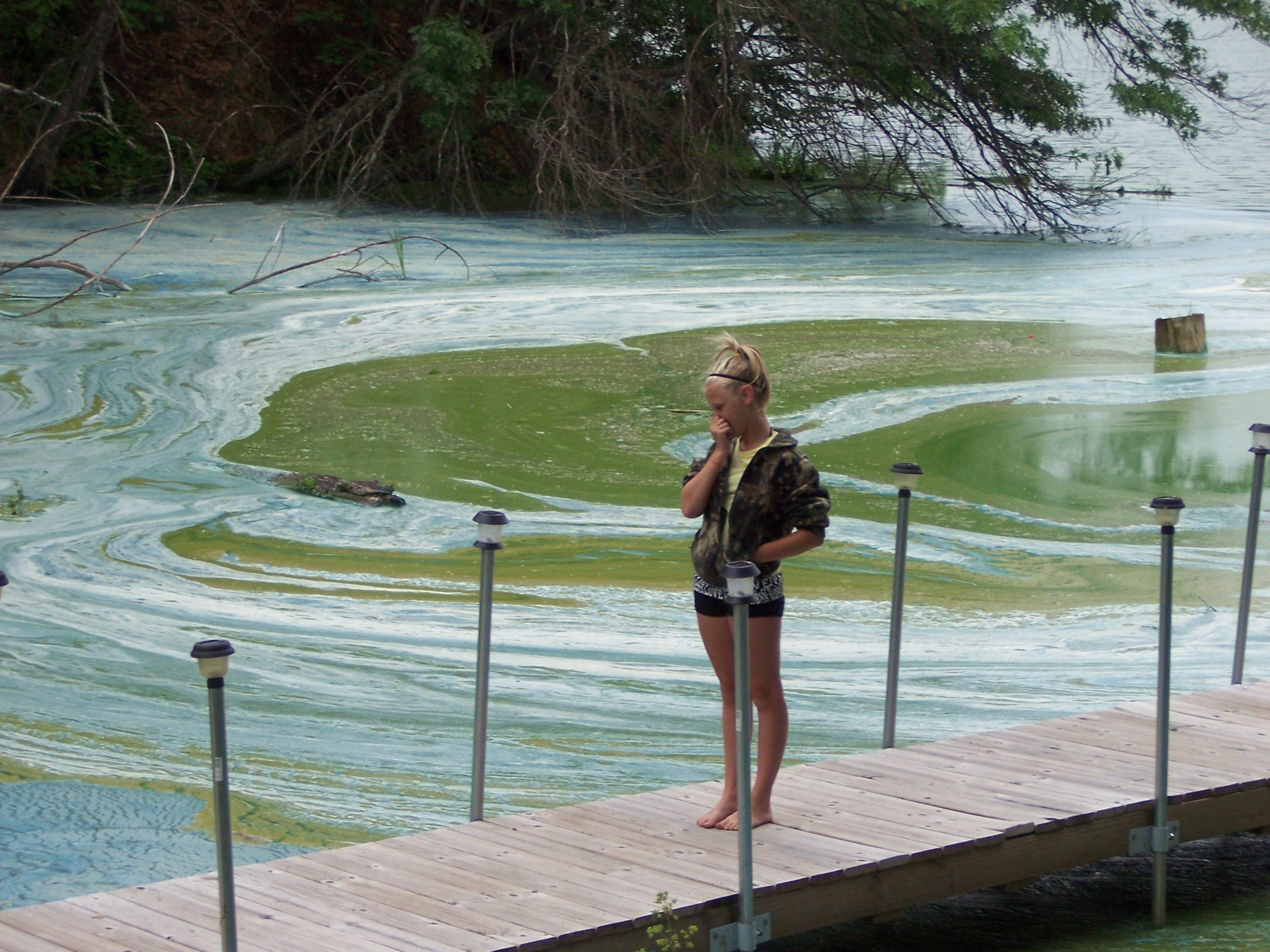
Algae bloom on Wisconsin’s Lake Tainter. (Photo by Peg McAloon.)
It’s a haunting remake of a 50-year-old tale: The Green Slime that Coated the Midwest. And this rehashed horror story is no work of fiction.
Like the classic film they may have inspired, the toxic blooms of blue-green algae that coated and stunk up the Great Lakes from the 1950s to the 1970s have returned to the region with a vengeance.
The blooms of decades past were fueled largely by decrepit sewage systems that spewed nutrient-rich human waste into the world’s largest body of fresh surface water. The modern remake, by contrast, is the handiwork of corporate agriculture.
Heavy rainfall in the farming region last spring and summer washed vast volumes of agricultural pollution into rivers and lakes, where it fueled poisonous blooms that sickened and disgusted residents and tourists and killed family pets.
Midwesterners describe some of last year’s blooms, particularly those in Lake Erie, as the worst in recent memory. And this year — despite much less rainfall washing into the lakes — is shaping up to be nearly as bad.
“It looked like green mud covering the entire lake,” said Rick Unger, president of the Lake Erie Charter Boat Association and one of 800 charter captains who makes a living from the lake, where shallow waters foster abundant fish and other wildlife. “It makes me sick thinking about it, and I’m sure my customers don’t want to come back.”
As the single-celled creatures that form the algae blooms grow, rot, and die, they poison the water, prevent needed light from reaching aquatic plants, and consume much of a lake’s oxygen.
Unger said the Lake Erie bloom was so “dense and thick” that it slowed down his motor, which spins two feet beneath the water’s surface. It was also so big it seemed to go on forever.
“I went 14 miles straight north out of Cleveland and never got out of it,” Unger added.
 Large corn and soy farms are mostly to blame, scientists and activists say, because they rely heavily on large quantities of phosphorous- and nitrogen-rich fertilizer that leach into the lakes, where they feed toxic blooms of cladophora and other nasty algae species. Manure from factory farms only adds to the nutrient load.
Large corn and soy farms are mostly to blame, scientists and activists say, because they rely heavily on large quantities of phosphorous- and nitrogen-rich fertilizer that leach into the lakes, where they feed toxic blooms of cladophora and other nasty algae species. Manure from factory farms only adds to the nutrient load.
Farmers retort by pointing out that many households are also wasteful when it comes to the use of lawn fertilizers, which enter the lakes through storm-water drains.
This year, parts of Lake Michigan have been home to foul thickets of blue-green algae throughout the summer, and a bloom was confirmed last month near the western shorelines of the normally pristine Lake Superior following heavy rainfall.
Health warnings have been issued in 20 states, with residents and visitors cautioned that potent toxins are lurking in the fetid waters.
Julie Van Stappen, a National Park Service official who works along the affected Apostle Islands National Shoreline, said such blooms are “extremely unusual” in Lake Superior. “It was fairly short-lived, but could occur again.”
On the bright side, this year’s blooms on Lake Erie are perhaps one-10th the size of last year’s, said Jeffrey Reutter, an Ohio State University lecturer who directs the Ohio Sea Grant College Program. But Reutter warned that the apparent respite there is fleeting, linked strictly to the current dry conditions.
“If we have a normal year or a wet year, we would predict that the problem will be right back,” Reutter said.
Instead of feeding complacency about the problem, Reutter said Lake Erie’s improvements this year should point to how rapidly the problem could be fixed — permanently — if farmers overhauled outdated practices.
Corn growers and other crop farmers should reduce the amount of fertilizer they apply to their fields and avoid over-fertilizing, according to Reutter. He also said they should dig the fertilizer into the soil instead of billowing it over the surface. “Those two steps would help immensely,” Reutter said.
Paul Bertels, a National Corn Growers Association vice president, said fertilizers account for perhaps one-quarter or one-third of a typical farm’s operating costs and that farmers don’t intend to waste that precious resource. Some farmers are beginning to apply fertilizer directly into the soil, instead of spraying it over the surface, he adds. And a growing number of the association’s members are applying fertilizer in stages throughout the growing season to help reduce waste.
The other big steps being taken by farmers to reduce the slime-inducing runoff include growing grass around creeks, which absorbs stray fertilizer, and minimizing tillage. Tillage is the practice of using farm machinery to churn soil over after a growing season, which can lead to erosion and dislodge nutrients from the soil.
The U.S. Natural Resources Conservation Service has long run programs — such as the Conservation Stewardship Program — that provide assistance to farmers who want to reduce soil erosion and prevent fertilizers from running off their farms. Those voluntary programs are helpful, Bertels said, but insufficient. And the next farm bill will undoubtedly include even less funding for them than is currently available, a shame because, as he said, there’s already “more demand for the projects than there is actual money.”
Despite years of piecemeal efforts by farmers and government officials to reduce farm runoff, the problem remains unresolved. “In order to eliminate blooms, we will need a lot more than those old federal [conservation] programs,” Reutter said.
Kim Wright, executive director of Midwest Environmental Advocates in Madison, said regulations covering agricultural pollution are woefully inadequate.
“The only farmers that need permits are the factory farms,” Wright said.
Wright was particularly scathing when discussing Wisconsin’s recent failure to pursue polluters under the leadership of Gov. Scott Walker (R).
Big questions remain about whether it’s possible to solve this problem without larger shifts in growing practice — namely, away from synthetic fertilizer-heavy monoculture and toward approaches that build farm soil in other ways, such as organic agriculture. The old-fashioned practice of growing legumes in the soil and then chopping down the plants and spreading them around, for example, increases the land’s fertility without upsetting ecological balances.
(Think agricultural reform is too difficult? If that’s the case, you are not alone: Shortsighted alternative “fixes” currently being pursued in various parts of the country include camouflaging algae with blue dye and killing it with a cocktail stew.)
If the haunting tale of toxic slime in the Midwest is ever going to let up, Wright thinks it needs to be regulated out of existence, strong-armed into oblivion like science data from a Republican-run congressional subcommittee.
“Corn is just a horrible blight on the environment, but people growing row crops are not required to do anything by law,” she said. “They just aren’t. And that’s the problem.”



